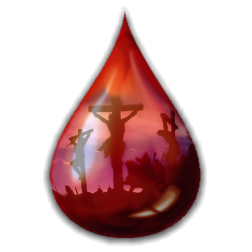
If we have never sought, we seek Thee now;
Thine eyes burn through the dark, our only stars;
We must have sight of thorn-pricks on Thy brow,
We must have Thee, O Jesus of the Scars.
The heavens frighten us; they are too calm;
In all the universe we have no place.
Our wounds are hurting us; where is the balm?
Lord Jesus, by Thy Scars, we claim Thy grace.
If, when the doors are shut, Thou drawest near,
Only reveal those hands, that side of Thine;
We know to-day what wounds are, have no fear,
Show us Thy Scars, we know the countersign.
The other gods were strong; but Thou wast weak;
They rode, but Thou didst stumble to a throne;
But to our wounds only God’s wounds can speak,
And not a god has wounds, but Thou alone.
I used to self-harm, and, as a result, have quite a large collection of scars on my arm. All of us, whether we self-harm(ed) or not, have scars on our bodies, and on our minds. They tell the story of our lives – the time we fell in the playground, the time someone hurt us, the time we hurt ourselves, making up a physical picture of who we are, and where we have been. For many self-harmers, the injuries we inflict are signs – in the words of C Blount:
How will you know I’m hurting
If you cannot see my pain?
To wear it on my body
Tells what words cannot explain.
Edward Shillito, the author of “Jesus of the Scars“, was a Free Church minister during the horrors of World War I. From that war, young men returned broken, if they returned at all, with horrific wounds and scars, the treating of which led to the development of plastic surgery. Here, Shillito gives a message to all who are wounded – soldiers, and ordinary people alike: only Christ can bring us comfort.
In the book of Isaiah, the coming Messiah is described as
“a man of sorrows, and acquainted with grief…he was wounded for our transgressions, he was bruised for our iniquities; upon him was the chastisement that made us whole, and with his stripes we are healed.” (Isaiah 53:3a, 5)
In the New Testament, the torture and death of Jesus is presented as a victory, rather than a defeat, and a glorification rather than the humiliation it was intended to be. Through Christ’s death, the believer is crucified with him (Rom 6:6; Col 3:3) and, like him, is resurrected (Rom 6:5-8; 2 Tim 2:11) so that Christ now lives in the believer (Gal 2:20). The wounds that Shillito writes about (thorn-pricks, hands, side) are the marks of Jesus’ Passion, the marks of his crucifixion and death. Those wounds are the signs of our salvation, signs shown to the Apostles when he first appeared to them after his resurrection (Luke 24:36-44; John 20:19-29).
So, when we are in pain, when we are wounded, when all seems dark, we are to remember that Jesus has been there too. He knows grief, sorrow, and agony – all the awfulness that being human can entail – and he, too, is scarred, just as we are. Christian faith is in an eternal wonder that God himself chose to become human, to become just like us, except without our sin, and that he chose to die for us, with all the betrayal and pain that implies. He is the wounded God, for a wounded humanity, a scarred Saviour for a scarred people. His wounds are the balm for ours, and our very woundedness is a sign of our need for him.
Let us, then, hold firmly to the faith we profess. For we have a great High Priest who has gone into the very presence of God—Jesus, the Son of God. Our High Priest is not one who cannot feel sympathy for our weaknesses. On the contrary, we have a High Priest who was tempted in every way that we are, but did not sin. Let us have confidence, then, and approach God’s throne, where there is grace. There we will receive mercy and find grace to help us just when we need it. (Heb 4:14-16 GNT)


 ‘Cutting Edge: Witnessing Rites of Passage in a Therapeutic Community’ Elizabeth Baxter
‘Cutting Edge: Witnessing Rites of Passage in a Therapeutic Community’ Elizabeth Baxter


